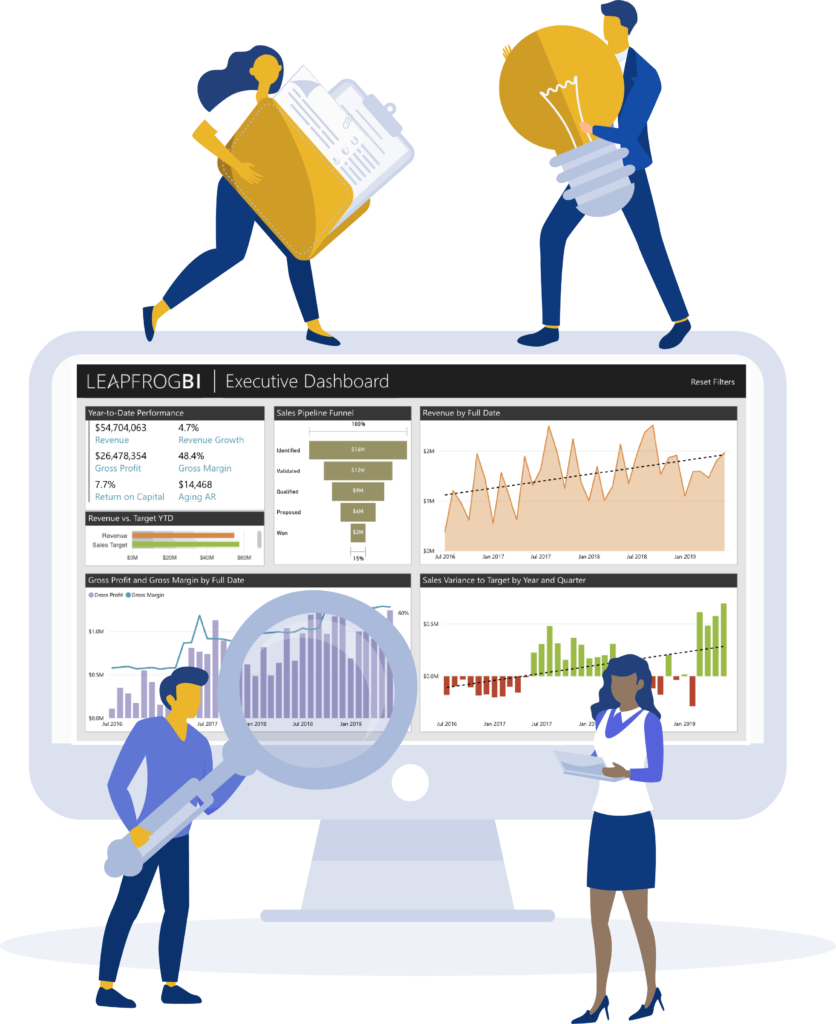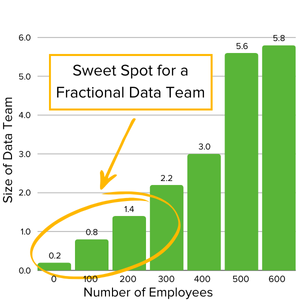Harness the power of a fractional data team
From its source to its end-user, data needs careful handling through every step of its journey. But along the way, different skills are required at different stages.
Hiring and retaining an in-house data team with a full-time employee for each skill is a burden that only the largest companies can afford.
That’s why a fractional data team just makes sense. It gives you all the skills and support you need, when you need it—without any of the extra responsibility.
Thinking about going fractional?


Ongoing analytics support that grows with you
Data powers decisions. It’s also a business function that supports your company’s core competencies. So why don’t you have a data team yet?
You have a finance team. You have an HR team. It may be time you have a data team, too.

Scalable reporting solutions tailored to your KPIs
As your company grows, so does the quantity and complexity of the data you create. Soon, data becomes everyone’s responsibility.
But this isn’t a sustainable way to scale. It’s only a matter of time until you reach a breaking point.
Build a data team before you get there.
What does a data team do?
A data team gathers, analyzes, and manages data to provide insights that drive decision-making and support strategic business initiatives. This includes:
- Ensuring data quality
- Building and maintaining data infrastructures
- Developing models to support analytical needs
- Creating reports to communicate insights
The data team’s goal is to ensure everyone has the information needed to make sound decisions, work efficiently, and ultimately capture opportunities.


What are the key roles in a data team?
- Business analysts determine business needs and then ensure the created technical solutions serve those needs.
- Data architects select the system components to build technical solutions and describe how they work together
- ETL developers write code to extract data from source systems and move it into a target model.
- Report developers work with BI tools to create graphical interfaces that support business analysis.
- Project managers oversee, organize, and orchestrate activities from all members of the data team.
- Data operations managers monitor all processes and activate remediation workflows when necessary.
Why choose a fractional data analytics team?
From a full-time, in-house team to staff augmentation, there are multiple strategies to building and managing a data team.
Data Team Type | Pros | Cons |
In-House |
|
|
Fully Outsourced |
|
|
Hybrid |
|
|
Fractional |
|
|
Why a fractional data team is superior
If you want a custom solution, accelerated delivery, and optimized costs, then a fractional data team is the only solution.
- Only pay for what you use, when you use it.
- Scale up or down as your needs change.
- Get expert insight from experienced industry specialists.
- Eliminate learning curves from faster deployment.
How can a fractional data team deliver results?
The company knew they were losing money.
ACME Healthcare, an independent, physician-owned medical practice, was facing the ultimate problem: They had more patients but were somehow making less money.
But they didn’t have the skills to figure out what was going wrong.
Their finance team tried to identify the problem—but they lacked both the time and the advanced skills necessary to integrate data from multiple sources into coherent, meaningful reports. To do that, ACME would have needed to spend $500,000 per year to create a new department and hire four full-time employees: a business analyst, a data engineer, a report developer, and a project manager.

They decided to hire a fractional data team, instead.
Enter LeapFrogBI’s Managed Analytics Services: a flexible, scalable offering that gives ACME the services of multiple specialized data professionals—no matter how much or how little they need.
LeapFrogBI built ACME an analytical data warehouse to not only understand why their profit margins were shrinking but to also monitor their financial and operational performance moving forward.
What are the results?
Read this data team post to discover how our data team transformed their business and got them back in the black.
At LeapFrogBI, clients trust our data team for fully-managed analytics
Ready to build your fractional data team?
- Every company has data. We help you turn that raw data into business sucess.
- LeapFrogBI gives you access to a full-service data team at your fingertips-for a little or as much help as you need, whenever you need it.
- Reserve a free, 30-minute consultation to learn how a fractional data team can transform your business.
FAQ
Start by defining the opportunities and setting clear goals and expectations. Determine what KPIs you’ll use to measure performance, as well as how (and how often) you’ll communicate. Above all, don’t rush systems onboarding. Take the time to properly integrate your fractional data team with your data systems, tools, documentation, etc., and introduce them with your key internal stakeholders.
Data is the engine that powers your business—so it’s natural to feel a little uneasy about inviting a fractional data team into your data systems. To ensure data security and confidentiality with external collaborators, don’t begin work until you’ve set up access controls and deployed encrypted channels for communication. Ask your fractional data team to sign an NDA. In addition, health care clients will need a HIPAA Business Associate Agreement.
Timelines will vary depending on a number of factors, such as project scope and data quality. For example, if the data you give your fractional data team isn’t clean and well organized, then it’ll take them extra time to prepare the data for analysis. In general, small to midsize goals can be completed by a fractional data team in several weeks, while larger milestones may take a few months. Managing data analytics is an essential ongoing business function.






















